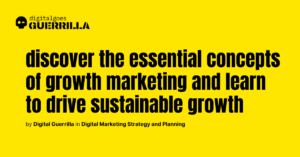In today’s hyper-competitive landscape, traditional marketing strategies often fall short. Businesses can no longer rely solely on flashy campaigns or big budgets to capture and retain customers. Growth marketing—a data-driven, iterative approach—has emerged as the go-to strategy for brands that want to scale sustainably. Yet, many still misunderstand its foundational principles, treating it as a buzzword rather than a practical framework.
This article dives into the basic concepts of growth marketing with a fresh perspective. Beyond the surface-level tactics, you’ll discover actionable insights and nuanced strategies to make growth marketing work for your business. Whether you’re a startup founder, a marketer, or a business leader, these concepts will help you rethink and refine your approach to growth.
1. Growth Marketing vs. Traditional Marketing: The Key Differences
To understand growth marketing, it’s essential to distinguish it from traditional marketing. Traditional marketing focuses primarily on brand awareness and top-of-the-funnel activities like advertisements, public relations, and event sponsorships. While effective for broad exposure, it often lacks the precision to drive measurable growth.
Growth marketing, on the other hand, leverages data, experimentation, and cross-functional collaboration to optimize every stage of the customer journey. From acquisition to retention and even referrals, growth marketing looks at the entire funnel. This holistic approach ensures that efforts are scalable, repeatable, and directly tied to business outcomes.
Example: A SaaS company employing traditional marketing might focus on driving sign-ups through paid ads. A growth marketer would test various messaging, optimize onboarding emails, and analyze customer churn rates to create a seamless journey from sign-up to subscription renewal.
2. The Growth Funnel: A Deep Dive into the AARRR Metrics
What are types of digital marketing funnel and how to choose the right one? One of the most critical concepts in growth marketing is the AARRR funnel (Acquisition, Activation, Retention, Referral, Revenue). Unlike the classic sales funnel, AARRR focuses on the full lifecycle of the customer. Here’s a breakdown:
- Acquisition: How are customers discovering your business? Evaluate the performance of each channel (SEO, paid ads, social media) using metrics like click-through rates and cost per acquisition.
- Activation: Are customers having a “wow” moment early on? Identify key actions that indicate engagement, such as signing up, completing a profile, or using a feature for the first time.
- Retention: How many customers are coming back? Track cohort retention rates to see if your product or service meets ongoing needs.
- Referral: Are your customers recommending you? Build referral loops that incentivize sharing and measure referral traffic and conversion rates.
- Revenue: Is your strategy profitable? Focus on customer lifetime value (CLV) and optimize pricing, upselling, and cross-selling strategies.
Practical Tip: Use tools like Google Analytics, Mixpanel, or Amplitude to track each stage of the AARRR funnel. Identify bottlenecks and run experiments to improve weak points.
3. Experimentation: The Engine of Growth Marketing
At the heart of growth marketing lies experimentation. Unlike traditional marketing campaigns, which often rely on assumptions, growth marketing tests hypotheses with real data. By running controlled experiments, marketers can uncover what truly drives growth.
Steps to Run Effective Growth Experiments:
- Define a Clear Hypothesis: For example, “If we reduce the sign-up form to three fields, conversion rates will increase by 15%.”
- Segment Your Audience: Test on a subset of your audience to minimize risk.
- Measure Results Accurately: Use statistically significant sample sizes and reliable analytics.
- Iterate and Scale: If the experiment succeeds, implement it broadly; if not, analyze why and try again.
Real-World Example: Dropbox famously used A/B testing to optimize their referral program. By tweaking copy, incentives, and landing page design, they achieved exponential growth.
4. Customer-Centric Data: The Foundation of Growth Decisions
Growth marketing thrives on understanding customer behavior through data. But not all data is created equal. To truly drive growth, you need to focus on actionable, customer-centric metrics rather than vanity metrics (e.g., follower count or website visits).
Actionable Metrics to Track:
- Customer Churn: Understand why customers leave and address root causes.
- Net Promoter Score (NPS): Gauge customer satisfaction and likelihood of referral.
- Time to Value (TTV): Measure how quickly customers derive value from your product.
Advanced Insight: Qualitative data (like customer interviews) complements quantitative data. While analytics tools show the “what,” customer conversations reveal the “why.”
5. Building Cross-Functional Teams for Growth
Growth marketing isn’t a solo effort. It requires collaboration across teams like product, engineering, sales, and customer support. Aligning these departments ensures seamless execution of growth strategies. What skills are crucial for a successful career in digital marketing?
Checklist for Cross-Functional Success:
- Clear Communication: Use tools like Slack or Asana to maintain transparency.
- Unified Goals: Ensure all teams are aligned on KPIs.
- Knowledge Sharing: Hold regular meetings to discuss findings and share insights.
Case Study: Airbnb’s growth team integrated product and marketing to create localized landing pages. This cross-functional approach helped them scale globally and improve bookings dramatically.
6. Leveraging Emerging Trends for Growth
The landscape of growth marketing is ever-evolving. Staying ahead requires embracing emerging trends like AI-driven personalization, influencer collaborations, and community-led growth.
Trend to Watch: AI tools like ChatGPT or Jasper can automate content creation, optimize ad campaigns, and even provide personalized customer experiences at scale. For instance, e-commerce brands can use AI to recommend products based on browsing history, boosting conversion rates.
Checklist: Are You Growth Marketing Ready?
- Have you mapped your growth funnel?
- Are you tracking meaningful KPIs?
- Do you have a testing framework in place?
- Are you prioritizing customer retention strategies?
- Have you explored viral loops or network effects?
FAQs: Growth Marketing Demystified
How is growth marketing different from traditional marketing?
Growth marketing focuses on the entire funnel, experimentation, and retention, while traditional marketing emphasizes top-of-funnel activities like awareness.
What’s the first step in starting a growth marketing strategy?
Start by mapping out your customer journey and identifying gaps in your funnel.
Can growth marketing work for small businesses?
Absolutely! Growth marketing principles, like experimentation and retention, are scalable and apply to businesses of all sizes.
Conclusion: Start Small, Think Big
Growth marketing is not about quick hacks or shortcuts; it’s about building a sustainable engine for long-term success. By focusing on the customer journey, running data-driven experiments, and fostering cross-functional collaboration, businesses can achieve scalable and repeatable growth.
Begin by analyzing your existing funnel, identifying weak points, and experimenting with solutions. Remember, growth is iterative. Each test, insight, and optimization brings you closer to unlocking your business’s full potential.
Bookmark this guide and revisit it as you refine your strategy. The journey to mastering growth marketing is ongoing, but with the right foundation, it’s a journey worth taking.
Read more about Digital Marketing Strategy and Planning ⬇️
- Why Growth Marketing Matters More Than Ever?

- Last-Minute Marketing Tips for a Successful Black Friday and Cyber Monday

- How to identify the most relevant channels for your target audience?

- How to establish benchmarks effectively and boost results?

- How to plan a digital marketing campaign?

- How to use geotargeting in digital marketing?
